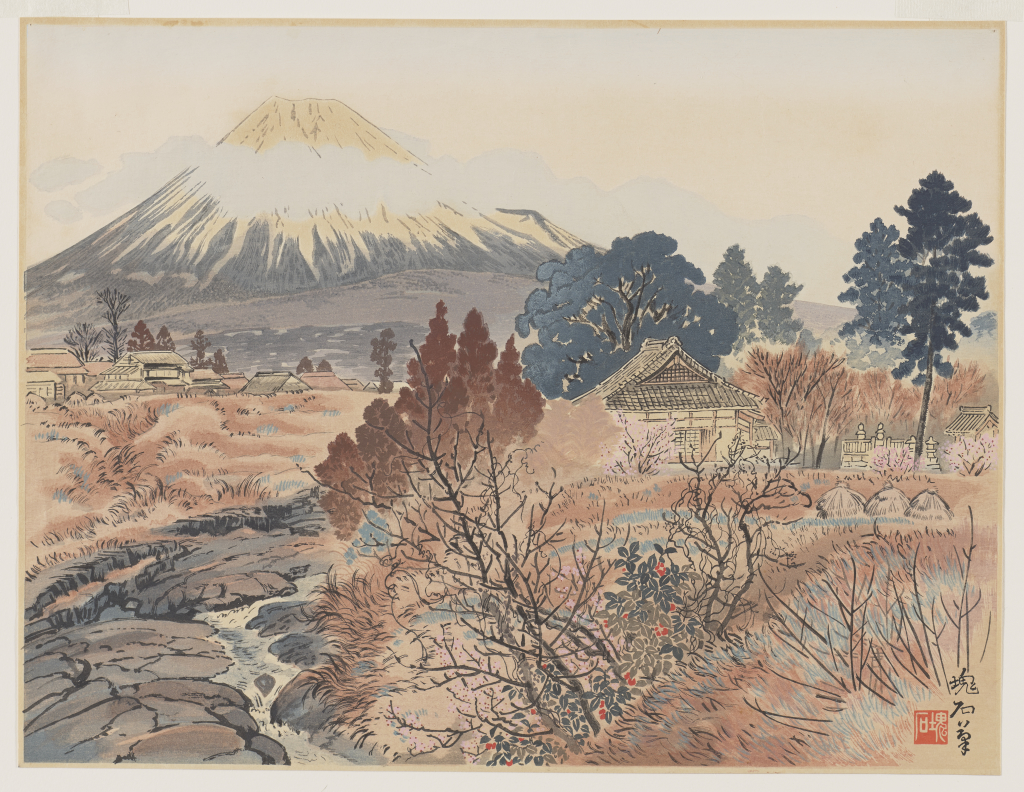Fukusenji to Fuji (Fukusenji Temple and Mount Fuji), from the series Fuji nijūgokei (Twenty-five Views of Mount Fuji)

Jōkata Kaiseki, Fukusenji to Fuji (Fukusenji Temple and Mount Fuji), from the series Fuji nijūgokei (Twenty-five Views of Mount Fuji), 1931, color woodblock print on paper; ōban nishiki-e, Gift of Judith P. Benson, public domain, 1995.60.2
This work is not currently on view.
- Title
Fukusenji to Fuji (Fukusenji Temple and Mount Fuji), from the series Fuji nijūgokei (Twenty-five Views of Mount Fuji)
- Related Titles
original language: 福泉寺と富士
series (original language): 富士二十五景
series (translated): Twenty-five Views of Mount Fuji
series (transliterated): Fuji nijūgokei
translated: Fukusenji Temple and Mount Fuji
transliterated: Fukusenji to Fuji
- Artist
- Date
1931
- Period
Japan: Shōwa period (1926-1989)
- Medium
color woodblock print on paper; ōban nishiki-e
- Dimensions (H x W x D)
image: 10 9/16 in x 13 7/8 in; sheet: 10 3/4 in x 14 1/16 in
- Inscriptions & Markings
artist's seal: 塊石 [stylized], printed in red intaglio within square cartouche, lower right Transliteration: Kaiseki Language: Japanese
seal: Kaiseki, lower right
signature: 塊石筆, printed in black ink, lower right Transliteration (Translation): Kaiseki hitsu (brushed [by] Kaiseki) Language: Japanese
- Collection Area
Asian Art; Graphic Arts
- Category
Prints
Japanese Traditional Prints
- Object Type
relief print
- Culture
Japanese
- Credit Line
Gift of Judith P. Benson
- Accession Number
1995.60.2
- Copyright
public domain
- Terms
Jōkata Kaiseki brings a painterly quality to the woodblock print medium in his series on Mount Fuji. This rural landscape resembles a watercolor painting, with grasses, leaves, and flowers made up of layers of wet-looking color unbound by the black outline typical of woodblock prints. Portable watercolor materials arrived in Japan from Europe in the late nineteenth century and made it easier for landscape artists to paint outdoors and express transient atmospheric effects. Kaiseki applies this new naturalism to the transcendent Fuji, bringing it back to earth and integrating it into a landscape filled with light and air.
- Exhibitions
2011 The Artist's Touch, The Craftsman's Hand: Three Centuries of Japanese Prints from the Portland Art Museum Portland Art Museum
2022; 2023 Human Nature: 150 Years of Japanese Landscape Prints Portland Art Museum









